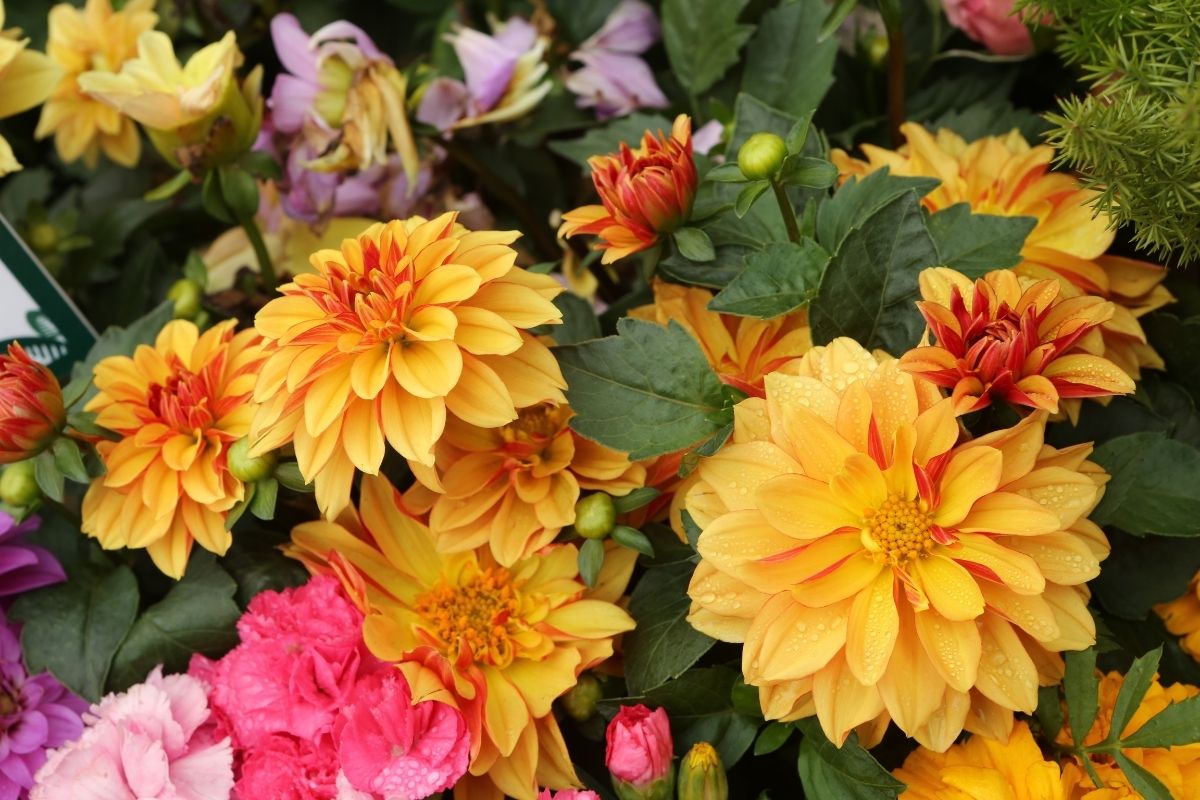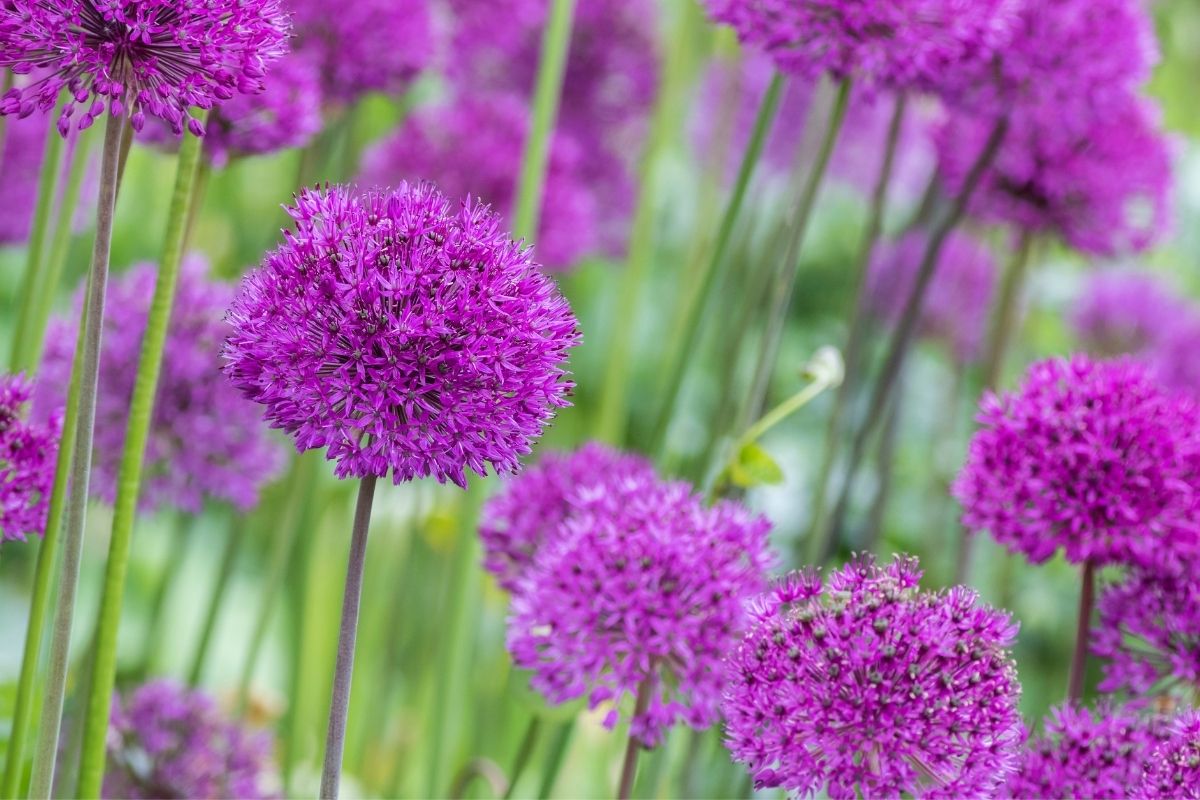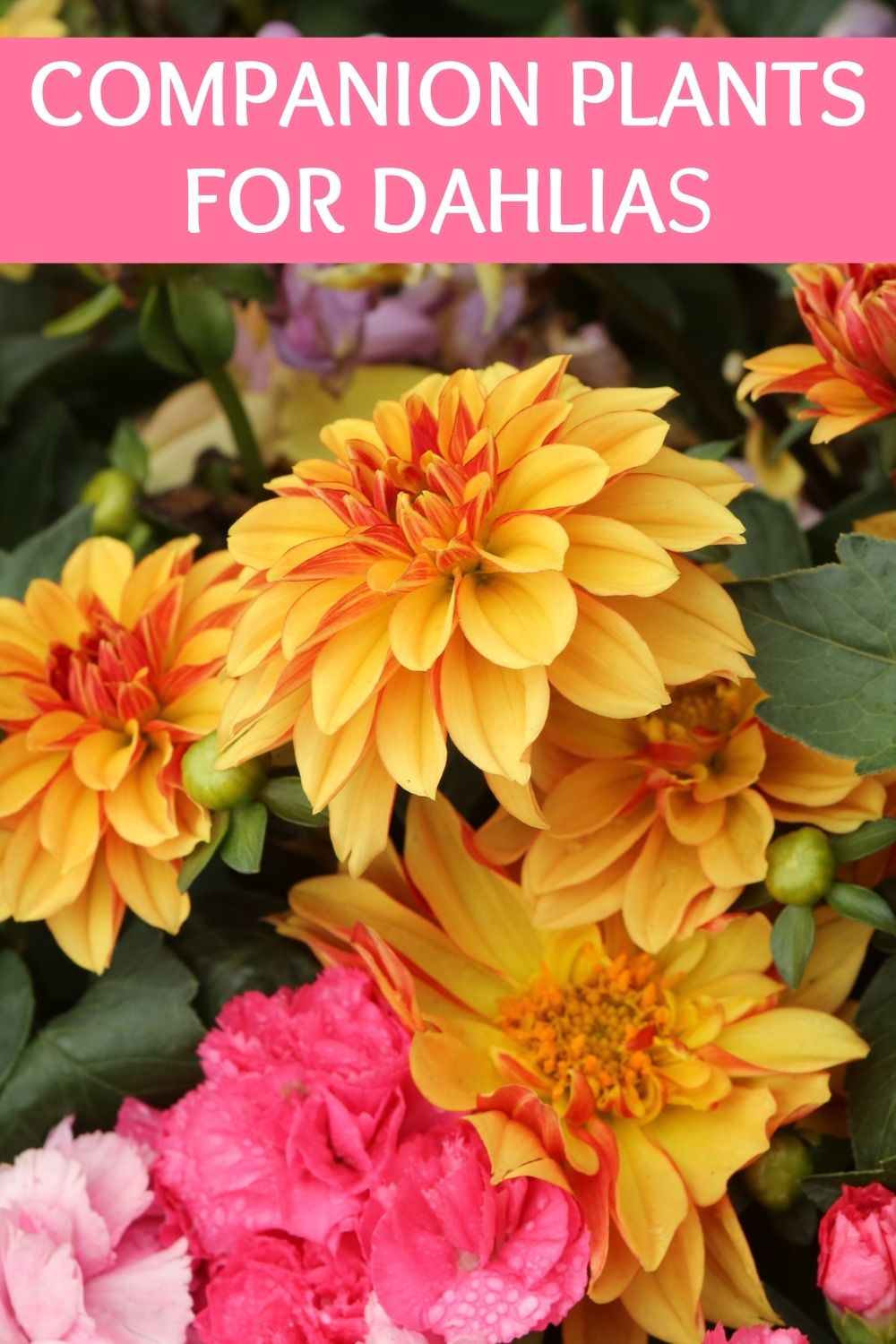Covered with large, cheerful blooms, very few flowering plants can match dahlias for the sheer joy that they bring to the garden. With an enormous variety of shapes, colors, and growth habits, chances are that you will be able to find a dahlia that fits into your garden plan. If you practice companion planting, you can minimize the need for pesticides and fungicides in your garden. If you’re looking for good plants to include with your dahlias, here are six great companion plants for dahlias.

Companion planting may seem magical, and in a way it is. When you plant certain plants together, they will draw beneficial insects into the garden. Additionally, good companions will also repel pesky insects that can be a real nuisance to your garden and maybe damage your treasured dahlias.
Companion plants will not only accent the beauty of your dahlias, but good companion plants for dahlias will also make them healthier, so they can grow more beautiful each year.
Learn more about growing dahlias, including how and when to fertilize dahlia plants.
Six Great Companion Plants for Dahlias
1. Coneflowers (Echinacea purpurea)
Easy to grow perennials that thrive on neglect, coneflowers are great companion plants for dahlias. These plants with their spiky foliage and stiff, cone-like flowers look beautiful against the lush, feminine dahlia. But not only do these two plants look great together, but coneflowers can also bring benefits to the dahlias. Coneflowers attract hummingbirds, butterflies, and bees to the garden, insects that increase pollination and add to the number of flowers in the garden.
Coneflowers are great to plant with dahlias because they have the exact same needs as the dahlias. They need well-drained soil in a sunny place. These plants do well in soils with average or below-average fertility. They are very easy to take care of, only needing to be deadheaded when the flowers fade.
In the fall, allowing the flowers to go to seed will attract birds that like to peck the seeds from the cone-shaped flower heads. When the seeds fall to the ground, they will sprout and give you more flowers.
2. Mugwort (Artemisia vulgaris)

Grown mostly for its gray-green silvery foliage, artemisia is a great companion for dahlias. The flowers of a dahlia look incredible against the showy leaves of the artemisia plants.
Artemisia foliage has many fragrant oils in its leaves, and these fragrance oils can repel unwanted pests. Slugs are drawn to dahlias as a general rule, and the artemisia plant will repel the slugs to keep your dahlias growing beautifully.
The fragrance oils in artemisia also tend to repel rabbits and deer that might munch your dahlias down to the ground.
Artemisia, also known as chrysanthemum weed, wild wormwood, or naughty man, is one plant that is fairly simple to grow. Once it is established in a sunny, well-drained spot, it needs very little care. Keep the soil evenly moist until it is established. Once the plants have taken hold, they can stand drought very well.
3. Alliums (any plant in the Allium family)

A member of the onion family, alliums are wonderful beneficial plants for the garden. Because they are a part of the onion family, they have extremely fragrant foliage and flowers. The fragrance oils in the plant confuse insects that might prey upon your dahlias.
These plants will deter cabbage maggots, carrot flies, aphids, and spider mites from bothering your dahlias. These plants also deter pesky rodents like voles, rats, and chipmunks.
Alliums love acidic soil, and they also need well-drained planting spots to avoid soggy roots. Alliums also need full sun to help them flower well. They often grow very tall and will shade out plants behind them, or obscure the blooms of a smaller plant.
Be sure to pay attention to the planting tags and note the final growth height of your allium. Also, if you plant alliums en masse, they will attract onion flies. For this reason, be sure to plant them in smaller clumps in the garden.
With more than 700 different varieties of alliums in the world, you are sure to find one that will fit into your planting scheme. These plants have gorgeous, showy flowers, and they don’t take up much space, making them a great companion plant for your dahlias.
4. Salvias (Salvia officinalis)
Salvias come in many different varieties, including various cultivars of the sage family. These plants have aromatic oils in the flowers and leaves which will repel slugs, deer, and rabbits that might make a meal out of your dahlia plants. The flowers are tall, upright, and spiky and they attract beneficial insects like bees and butterflies.
Salivas have similar needs to dahlias, which is another thing that makes them great companion plants for dahlias. Salvias can handle full sun to partial shade. They also need well-drained soil, though they can handle poorer soils well. Once they are established, salvias do not need tons of water and can handle occasional droughts in the summer.
5. Nasturtium (Tropaeolum majus)
Nasturtiums not only add lovely colored flowers and unusual foliage to your garden, but they also attract beneficial insects like bees, butterflies, and mantids to the garden. Nasturtiums also repel pests like aphids and cucumber beetles that pierce the stems of the dahlias and suck out the life-giving nutrients of the plants.
Nasturtium plants can be grown from seed. You can directly sow the seeds in the garden in a sunny, well-drained spot after the last frost date for your area. Plant the seeds about an inch deep and about 8 to 10 inches apart. Nasturtiums can also stand a bit of shade, so if the dahlias cast shade on them at certain times of day, they will do just fine.
6. Geraniums (any plant in the Pelargonium family)
Geraniums have bright, cheerful flowers on erect stalks. They come in a staggering array of colors, from white to red to pink and all the shades in between. Geraniums also have lovely foliage that comes in a variety of colors that will add beauty to your garden.
They are good companions for dahlia plants because they draw Japanese beetles away from the dahlias. The beetles will munch on the dahlias, unless you give them an alternative food source, like some geraniums.
Japanese beetles prefer geraniums to dahlias, so when you plant the geraniums, they will leave the dahlias alone. This is great because you will not have to spray toxic chemicals on your plants to keep the beetles from decimating your dahlias.
Geraniums need at least six hours a day of sunlight and well-drained soil. Cutting back new growth will help the plants stay tidy. If you do not prune your geraniums, they will grow leggy and awkward. The fading flowers also need to be dead-headed to keep the plant flowering prolifically.
These plants do well in average to poor soils. You should only fertilize your geraniums in the early part of the season. If you apply too much fertilizer, it will redirect energy to making beautiful foliage and fewer blooms. Geraniums can be brought indoors in the winter and replanted next spring.
More beautiful dahlia companions
The 6 plans above are just a few of the many colorful flowers that look good with dahlias. Here are just a few more quick ideas to add to your dahlia dream garden:
- herbs such as rosemary, mint, coriander, anise, and thyme
- giant hyssop
- asters
- glove thistle
- cranesbill
- rose campion
- stonecrop
- African lily
- Peruvian lily
- crocosmia
- sneezeweed
- bee balm (check out these 8 companion plants for bee balm)
- and many more
Tips for Growing Dahlias
Dahlias are very easy flowers to grow and give you plenty of bang for your buck, developing gorgeous showy flowers for months during the growing season.
Soil pH
Dahlias do best in slightly acidic soil, so be sure to check the pH of your soil before you plant them. You can amend the soil with compost to help alter the pH.
Sunlight
While dahlias can take some shade, to flower well they need about eight hours of sunlight per day.
Deadheading
Dahlia plants will flower prolifically, but only if you snip off the dead and fading flower heads. This practice is called deadheading. It only takes a few minutes every few days to keep your dahlias looking great.
Correct water amount
Dahlias grow from tubers, fleshy root structures that store energy and water. Because these tubers have water already inside them, excessive water may cause them to rot or develop fungal diseases. Only water the plants once the sprouts have emerged from the tubers. Be sure that you plant them in a place that has well-drained soil.
Dig them up in the fall
If you live in a place that has hard frosts all winter, you should dig up the dahlia tubers in the fall after the first frost kills the foliage. Shake all of the dirt from the plants’ roots and store them in a place that is cool, but not freezing, like the garage or basement. You can plant them again in the spring after the last frost date.
Dahlias have a huge size range from 15 inches all the way up to 6 feet in height and diameter. They may have tiny flowers about 2 inches across or have flowers that are about 10 inches in diameter.
Some of the flowers are delicate and feminine while others are boldly colored and showy. No matter which dahlia you choose, they are sure to be an asset to your garden. Be sure to choose some of the above-listed companion plants for dahlias that will help them grow strong and healthy.








What Is The Best Fertilizer For Dahlias
Friday 5th of May 2023
[…] of gorgeous blooms from early summer through late fall. Enjoy a dahlia garden in your front yard (check out these dahlia companion plants), or use them as cut flowers to make bouquets for yourself or a […]
Companion Planting Guide (Including 7 Benefits Of Polyculture)
Monday 11th of July 2022
[…] Companion plants for dahlias […]
How To Grow Dahlias For Gorgeous Colors In The Garden
Tuesday 5th of April 2022
[…] Here are some great companion plants for dahlias. […]